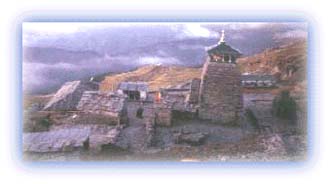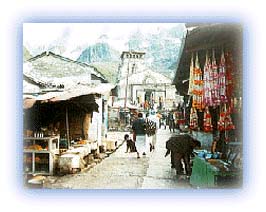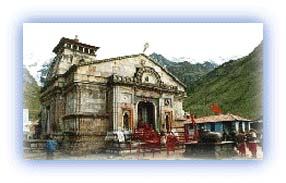Garhwal himalayas
General info
· Uttarakhand
· Eastern Garhwal
· Route to Badrinath
· Haridwar
· Rishikesh
· Devaparayag
· Srinagar
· Rudraprayag
· Chamoli
· Joshimath
· Badrinath
· Mana and Niti
· Valley of Flowers
· Hemkund Sahib
· Nanda Devi Sanctuary
· Nanda Devi
· Inner Sanctuary
· Outer Sanctuary
· Present-day Scenario
· Western Garhwal
Other Places of Interest
· Uttarkashi
People
· Jaunsaries
· Jadhs
· Marchas
· Bhotias
Religion
· Gods and Goddesses
Flora and Fauna
· Wildlife

![]()
|
Route to Kedarnath The pilgrimage to Kedarnath, the abode of Lord Shiva in the Himalayas, still retains its pristine grandeur. It is one of the "char dhams" in Uttarakhand, the others being Badrinath, Yamunotri and Gangotri. The motor road follows the Badrinath- Rishikesh route up to Rudraprayag, where the Mandakini flowing from Kedarnath joins the Alaknanda flowing from Badrinath. |
 |
| Tungnath, the highest Hindu shrine in the inner Himalayas. It is a Panch Kedar - one of the five temples in Garhwal, where Lord Shiva is worshipped. Credit: Discover India |
The road bifurcates, and one follows the road up the valley of the Mandakini river. Unlike the neighboring Alaknanda Valley, this valley is a lot more gentle, with lush green fields and forests all around. The road moves up to Gaurikund, which is the road head. Gaurikund is the place where Parvati, the consort of Lord Shiva, is believed to have meditated for obtaining his hand. It was once a lovely hamlet and till recently could be reached only after trekking a few kilometers. However, the extension of the motor road till Gaurikund and the restaurants that sprung up to cater to the tourists have affected the place adversely. Suffocating crowds, horse stables and constant traffic snarl-ups are now a regular feature of this town, which was simply not designed to cope with such heavy traffic.
The trekker does well to immediately pass through the town and walk towards Kedarnath. After making one's way past the horse stables lined up beside the road for a kilometer, the noise level dies down somewhat, and one begins to enjoy the trek. It is a magnificent climb through tumbling waterfalls and alpine forests, with the spectacular Kedarnath peak in the distance. Pilgrims often prefer the easier pony rides but these simply cannot match the enjoyment of walking along this lovely trail.
 |
| Approaching the Kedarnath Temple Credit: Raj Shirole |
The town of Kedarnath lies in a cup-like valley surrounded by lofty snow-clad peaks. The borderline between fact and fantasy is blurred in this area where on the one hand the religious fever borders on the ecstatic and on the other nature overwhelms one with its majesty. Lord Shiva's temple at Kedarnath is one of the twelve Jyotirlingas (sacred places) dedicated to him.
The temple sits in the shadow of the Kedarnath massif, which is a group of three peaks and ridges. The temple has such character that it has attracted pilgrims from all over the country for centuries. It is said to have existed in a lesser form during the reign of the Pandava kings from the ancient Indian epic of Mahabharata.
 |
| The Kedarnath Temple Credit: Raj Shirole |
According to the legend, the Pandavas traveled in the Himalayas trying to catch a glimpse of Lord Shiva, who carefully avoided them. At Kedarnath, the Pandavas found a herd of bulls grazing. The Pandavas managed to recognize Lord Shiva as one of the bulls. As Bhima, one of the Pandava brothers, tried to grab the bull, it disappeared into the ground, leaving only its hump at Kedarnath. Other parts of his body manifested in temples around Garhwal.
All rights reserved